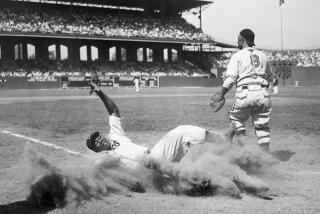Dominican shift
- Share via
SANTO DOMINGO, Dominican Republic -- For decades, this island’s gifted young baseball prospects weren’t hard to find or sign -- if those in the small fraternity of major league scouts were willing to beat the bushes and endure the hardships to track them down.
“When we went to the countryside, to little towns for tryouts, sometimes we would sleep and eat in our jeep because there were no hotels,” recalled Ralph Avila, a longtime Dodgers scout who signed All-Stars Pedro Martinez, Raul Mondesi and Jose Offerman.
And because the country’s high unemployment and poverty rates often left many young Dominicans with no options other than the ball fields or the cane fields, these prospects usually took whatever was offered for a chance to play professional baseball.
But now, with more than $84 million a year pouring in from Major League Baseball, seemingly everyone here is getting into the talent procurement act, bringing a jolt of free-market competition to an economic backwater.
Some of these independent scouts are retired major leaguers coming home and setting up training academies. Others represent U.S.-based agencies such as the Scott Boras Corp. and Wasserman Media, among others. Then there are the many local freelancers, including women and even a few nuns, who hope to claim a share of this growth industry, scouring city streets and dusty sandlots in search of promising youngsters.
They are known locally as buscones, or searchers.
“Dominicans have begun to assert a degree of control in the creation of this baseball product that we didn’t see 20 years ago,” said Alan M. Klein, a cultural anthropologist who has written extensively on baseball in Latin America. “And that’s a good thing.”
Not to mention profitable. Last year, the 30 big league teams signed 511 Dominicans for an average bonus of $65,821 -- double the average teams paid only three years ago and more than 30 times what the Oakland Athletics paid to sign former American League most valuable player Miguel Tejada in 1993.
“Buscones are now helping to change that,” said Frank Cabrera who, like many Dominican talent scouts, likens the old system to exploitation. “Before a player signed for $1,000, $1,500, because there was nobody to judge his value. It’s going to be much better now.”
But the downside, say major league scouts, is that many prospects are less educated and less prepared to play professional baseball than players they signed a few years ago.
“In the past when you signed players they got to you with a little more discipline about the game . . . more love for the game, for baseball,” Tampa Bay Rays scout Eddy Toledo said. “Now the buscones, they just work out with them. At the time you get the player, if he’s a pitcher maybe he hasn’t thrown even 15 innings his entire life. If he is a position player maybe he hasn’t had even 30 at-bats in a game situation.”
They also complain that the sheer number of unregulated buscones has made it impossible for them to find young talent first and that by serving as scout, coach and agent, the independents have exploited players themselves while driving up the costs of doing business in the Dominican.
For Avila, they have also stolen the thrill of the chase.
“I don’t like [it] at all,” he said. “It’s more easy now for the [major league] scouts. They don’t have to travel.”
Although freelance scouts or “bird dogs” have existed in the Dominican Republic almost as long as baseball has, independent buscones didn’t become a factor until about 10 years ago. Their ranks now include ex-Angel Luis Polonia and former Dodgers Jose Lima and Ramon Martinez, who run large academies, as well as youth coaches who train neighborhood kids, then refer them to bigger academies for a fee.
“Everybody has a program. Nuns I know have said to people, ‘Hey, I’ve got somebody for you,’ ” said Klein, who estimated there are as many as 2,500 buscones working on the island. “So the buscones have evolved into a multipurpose, multidimensional kind of entity from a single bird dog.”
Added Clay Daniel, the Angels’ supervisor of international scouting: “I’ve had quite a few lady buscones. You’ve got Americans down there being buscones. You’ve got Cubans. You’ve got the natives. It’s amazing.”
To many scouts, it’s also maddening. Major league teams must wait until a player turns 16 to sign him, while the buscones may do as they please.
Some have taken players out of school and provided them with food, vitamins, training and housing. Once the players become old enough to sign, the buscones showcase them for several teams to drive the bonus offers higher.
“Because so many buscones are working now, most of the organizations depend on them,” Avila said.
That’s a major departure from the days when scouts would comb the island, hold clinics and establish relationships with a prospect’s parents, then make a low-ball offer the parents wouldn’t think of refusing.
“I love the old-fashioned system,” said Toledo, who has signed more than 20 major leaguers, including New York Mets All-Star shortstop Jose Reyes. “That is really scouting for me. And my scouts that I direct, I say the same thing: Try to find [players] ahead of the buscones.
“But we’re never going to defeat them. Never,” he added, because the buscones can target players younger than 16. “We’re not allowed to do that.”
As a result, some former major league scouts have gone into business for themselves. Epy Guerrero, who along with Avila pioneered the idea of a baseball training academy in the Dominican, recently severed his ties with big league teams after 37 years to open a private program.
With one major difference.
“In the last three years I’ve made more money than I would have made with an organization,” he said.
That is because buscones often determine not just which team a player signs with, but the size of the signing price as well. For that they are well compensated, regularly taking 30% of the bonus -- more than five times the commission U.S.-based agents typically charge.
At first such high fees led to protracted fights between players and their buscones -- the battle between Enrique Soto and former Dodgers prospect Willy Aybar became so heated the Dodgers began withholding payments to Aybar, while other disputes have landed in court.
Buscones, however, insist their prices are cheap, given the investments in food, housing and training they make for players who might not ever be signed by a professional team.
“People have come to accept that as something that is the standard in the industry,” said Ronaldo Peralta, who runs baseball’s Latin American operations from Santo Domingo. “And it is standard in most of the contracts that families sign with agents or buscones.”
But the buscones’ actual costs are far less than what the players are charged, Peralta said.
“By our standards it looks like exploitation,” Klein said. “But in terms of the straight-up economy or what it takes to develop a program and get these guys to a showcase, it’s not necessarily that outrageous.
“It’s just unregulated. And that’s what drives Major League Baseball crazy.”
Even so, business is booming, with the number of players signed up more than 100 since 2005.
Bonuses have more than doubled since 2004, so even after lopping 30% off the top, more players are signing and they are pocketing much more money than they would have under the old system.
And that has drawn the attention of many U.S.-based agents, who find working with Dominican prospects to be more profitable and predictable than dealing with Americans, who frequently have choices coming out of high school and can spurn the pros for a college scholarship.
Eighty-eight Dominicans were on opening-day major league rosters this season, 10 fewer than last year’s record but nine more than in 2004. And about 2,200 Dominican minor leaguers were under contract to big league teams, a jump of more than 40% from three years earlier.
But despite the fact annual signings continue to climb, teams such as Tampa Bay are beginning to look at comparatively untapped countries such as Venezuela and Colombia, which have roughly triple the population of the Dominican.
Baseball, however, isn’t likely to fade away here any time soon. Nor will the buscones, says Klein, the cultural anthropologist.
“[The players] get fed better. They’re clothed. They’re housed,” he said. “In many cases that’s a major step up for a lot of these kids. Most Dominicans, they know that the buscones are vital and essential.”
--
--
Begin text of infobox
PEDRO MARTINEZ
* Age:36.
* Birthplace: Manoguayabo, Dominican Republic.
* Position: Pitcher.
* Signed by the Dodgers as an amateur free agent in 1988.
* Current team (average salary): New York Mets ($11.8 million).
--
JOSE REYES
* Age: 24.
* Birthplace: Villa Gonzalez, Dominican Republic.
* Position: Shortstop.
* Signed by the New York Mets as an amateur free agent in 1999.
* Current team (average salary): New York Mets ($5.8 million).
MIGUEL TEJADA
* Age: 31.
* Birthplace: Bani, Dominican Republic.
* Position: Shortstop.
* Signed by the Oakland Athletics as an amateur free agent in 1993.
* Current team (average salary): Houston Astros ($14.8 million).
--
Sources: Associated Press and baseball-reference.com
More to Read
Sign up for Essential California
The most important California stories and recommendations in your inbox every morning.
You may occasionally receive promotional content from the Los Angeles Times.














